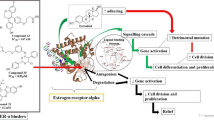Abstract
The estrogen receptor (ER) is the most valuable target in cancer therapeutics. The ER signal transduction pathway controls breast and endometrial tumor cell replication. Members of the group of medicines called Selective ER Modulators such as tamoxifen or raloxifene are antiestrogenic in the breast tumor but can build bone in postmenopausal women. Tamoxifen is used ubiquitously to treat all stages of breast cancer and to prevent breast cancer in high-risk women. Raloxifene is used to prevent breast cancer in high-risk postmenopausal women as to treat osteoporosis and prevent breast cancer at the same time.
Access this chapter
Tax calculation will be finalised at checkout
Purchases are for personal use only
Similar content being viewed by others
References
Chen J, Kim J, Dalton JT. Discovery and therapeutic promise of selective androgen receptor modulators. Mol Interv. 2005;5:173–88.
Couse JF, Korach KS. Estrogen receptor null mice: what have we learned and where will they lead us? Endocr Rev. 1999;20(3):358–417.
Cummings SR, et al. The effect of raloxifene on risk of breast cancer in postmenopausal women: results from the MORE randomized trial. Multiple Outcomes of Raloxifene Evaluation. J Am Med Assoc. 1999;281:2189–97.
Cummings SR, et al. Lasofoxifene in postmenopausal women with osteoporosis. N Engl J Med. 2010;362:686–96.
Deroo BJ, Korach KS. Estrogen receptors and human disease. J Clin Investig. 2006;116(3):561–70.
Haddow A, Watkinson JM, Paterson E. Influence of synthetic oestrogens upon advanced malignant disease. Br Med J. 1944;2:393–8.
Jensen EV, Jordan VC. The estrogen receptor: a model for molecular medicine. The Dorothy P. Landon AACR Prize for Translational Research. Clin Cancer Res. 2003;9:1980–9.
Jordan VC. Selective estrogen receptor modulation: concept and consequences in cancer. Cancer Cell. 2004;5(3):207–13.
Jordan VC. Tamoxifen (ICI46,474) as a targeted therapy to treat and prevent breast cancer. Br J Pharmacol. 2006;147(S1):S269–76.
Jordan VC. Tamoxifen: catalyst for the change to targeted therapy. Eur J Cancer. 2007;44(1):30–8.
Jordan VC. The 38th David A. Karnofsky lecture: the paradoxical actions of estrogen in breast cancer – survival or death? J Clin Oncol. 2008;26(18):3073–82.
Jordan VC. A century of deciphering the control mechanisms of sex steroid action in breast and prostate cancer: the origins of targeted therapy and chemoprevention. Cancer Res. 2009;69:1243.
Jordan VC, O’Malley BW. Selective estrogen receptor modulators and antihormonal resistance in breast cancer. J Clin Oncol. 2007;25(36):5815–24.
Masood S. Estrogen and progesterone receptors in cytology: a comprehensive review. Diagn Cytopathol. 1992;8:475–91.
McGuire WL. Estrogen receptors in human breast cancer. J Clin Investig. 1973;52(1):73–7.
Miller WR. Background and development of aromatase inhibitors. In: Furr BJA, editor. Milestones in drug therapy: aromatase inhibitors. Basel: Birkhauser; 2006. p. 1–21.
Prat A, Perou CM. Deconstructing the molecular portraits of breast cancer. Mol Oncol. 2011;5(1):5–23.
Van Slooten HJ, Van Dierendonck JH, Van der Velde CJH. Prognostic and predictive factors in invasive breast cancer. In: Tobias JS, Houghton J, Henderson IC, editors. Breast cancer: new horizons in research and treatment. Oxford: Arnold; 2001. p. 50–71.
Vogel VG, et al. Update of the national surgical adjuvant breast and bowel project study of tamoxifen and raloxifene (STAR) P-2 trial: preventing breast cancer. Cancer Prev Res. 2010;3:696–706.
Author information
Authors and Affiliations
Corresponding author
Editor information
Editors and Affiliations
Rights and permissions
Copyright information
© 2017 Springer Science+Business Media New York
About this entry
Cite this entry
Sweeney, E.E., Jordan, V.C. (2017). ER. In: Marshall, J. (eds) Cancer Therapeutic Targets. Springer, New York, NY. https://doi.org/10.1007/978-1-4419-0717-2_14
Download citation
DOI: https://doi.org/10.1007/978-1-4419-0717-2_14
Published:
Publisher Name: Springer, New York, NY
Print ISBN: 978-1-4419-0716-5
Online ISBN: 978-1-4419-0717-2
eBook Packages: Biomedical and Life SciencesReference Module Biomedical and Life Sciences




